 W
WAetosauroides is an extinct genus of aetosaur from the Late Triassic of South America. It is one of four aetosaurs known from South America, the others being Neoaetosauroides, Chilenosuchus and Aetobarbakinoides. Three species have been named: the type species A. scagliai, A. subsulcatus and A. inhamandensis. Fossils have been found in the Cancha de Bochas Member of the Ischigualasto Formation in the Ischigualasto-Villa Unión Basin in northwestern Argentina and the Santa Maria Formation in the Paraná Basin in southeastern Brazil. The strata date to the late Carnian and early Norian stages, making Aetosauroides one of the oldest aetosaurs.
 W
WArcheopelta is an extinct genus of carnivorous archosauriform from the late Middle or early Late Triassic period. It was a 2 m (6 ft) long predator which lived in what is now southern Brazil. Its exact phylogenetic placement within Archosauriformes is uncertain; it was originally classified as a doswelliid, but subsequently it was argued to be an erpetosuchid archosaur.
 W
WBrasilitherium, from "Brazil" and therium, thus meaning "Brazilian beast", is an extinct genus of cynodonts that lived during the Middle to Late Triassic in what is now Brazil. It was approximately 12 centimetres (4.7 in) long and weighed around 20 grams (0.044 lb). It probably fed on insects. Brasilitherium was found in the Candelária Formation of the Paraná Basin in southeastern Brazil. Brasilitherium represents a transition between advanced cynodonts and mammals, having features of both and having early evolution of certain mammalian features, such as hearing and a nasal cavity.
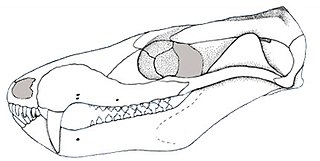 W
WBrasilodon is an extinct genus of cynodonts that lived during the Norian age of the Late Triassic Period, about 228 to 208.5 million years ago. The average length of Brasilodon is approximately 12 cm and weighed about 20 grams. The average size of this cynodont species is about the size of extant mice. Brasilodontids are most likely insectivores due to their teeth. The two species in this genus are B. tetragonus and B. quadrangularis, two very small cynodonts belonging to the family Brasilodontidae.
 W
WBuriolestes is a genus of early sauropodomorph dinosaurs from the Late Triassic Santa Maria Formation of the Paraná Basin in southern Brazil. It contains a single species, B. schultzi, named in 2016. The type specimen was found alongside a specimen of the lagerpetid dinosauromorph Ixalerpeton.
 W
WThe Candelária Formation, in other literature also referred to as Candelária Sequence, is a sedimentary formation of the Santa Maria Group in the Paraná Basin in Rio Grande do Sul, southeastern Brazil. The formation dates to the Carnian of the Late Triassic, locally referred to as Tuvalian, from 231.4 to approximately 222 Ma.
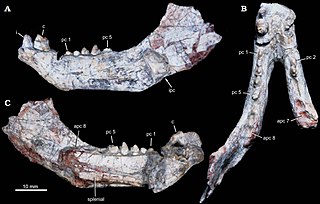 W
WCandelariodon is an extinct genus of carnivorous cynodonts from the Middle Triassic Santa Maria Formation of the Paraná Basin in Rio Grande do Sul state, Brazil. Candelariodon is known from a partial mandible having some complete teeth. It was collected from the Santa Maria Formation. It was first named by Téo Veiga De Oliveira, Cesar Leandro Schultz, Marina Bento Soares and Carlos Nunes Rodrigues in 2011 and the type species is Candelariodon barberenai.
 W
WThe Caturrita Formation is a rock formation found in Rio Grande do Sul, Brazil. Its sediments were deposited in the Paraná Basin. The formation is from the Upper Triassic and forms part of the Santa Maria Supersequence in the upper section of the Rosário do Sul Group.
 W
WChanaresuchus is an extinct genus of proterochampsian archosauriform. It was of modest size for a proterochampsian, being on average just over a meter in length. Fossils are known from the Middle and Late Triassic of La Rioja Provence, Argentina and Rio Grande do Sul, Brazil. The type species and only currently known species is Chanaresuchus bonapartei was named from the Ladinian-age Chañares Formation in 1971. A second species C. ischigualastensis named in 2012 from the late Carnian-age Ischigualasto Formation, was briefly assigned to Chanaresuchus before being moved to its own genus Pseudochampsa in 2014. C. bonapartei has recently been found in the Carnian Santa Maria Formation in Brazil. Chanaresuchus appears to be one of the most common archosauriforms from the Chanares Formation due to the abundance of specimens referred to the genus. Much of the material has been found by the La Plata-Harvard expedition of 1964-65. Chanaresuchus was originally classified in the family Proterochampsidae, although it has been placed in the family Rhadinosuchidae in more recent studies.
 W
WChiniquodon is an extinct genus of carnivorous cynodonts, which lived during the Late Triassic (Carnian) in South America and Africa. Chiniquodon is closely related to a contemporary genus, Probelesodon, and close to the ancestry of mammals.
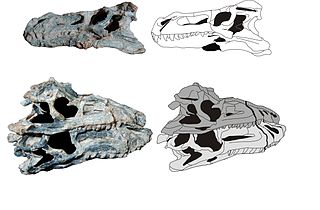 W
WDecuriasuchus is an extinct genus of loricatan from the Middle Triassic period. It is a carnivorous archosaur that lived in what is now southern Brazil, in Paleorrota. It was first named by Marco Aurélio G. França, Jorge Ferigolo and Max C. Langer in 2011 and the type species is Decuriasuchus quartacolonia. The generic name means "legion of ten crocodile" in Greek in reference to the ten known specimens and the animal's possible group behavior. The specific name refers to the Quarta Colonia region where the fossils were collected.
 W
WDinodontosaurus is a genus of dicynodont therapsid. It was one of the largest herbivores of the Triassic and had a beak corneum. It lived in the Middle Triassic but disappeared in the Upper Triassic.
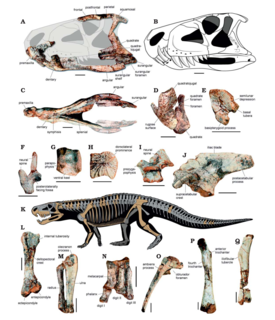 W
WDynamosuchus is an extinct genus of pseudosuchian archosaurs from the family Ornithosuchidae. It is known from a single species, Dynamosuchus collisensis, which is based on a partial skeleton from the Santa Maria Formation of Brazil. Dynamosuchus is considered a close relative of Venaticosuchus, which is known from the Ischigualasto Formation of Argentina. Ornithosuchids are one of many groups which lived in the Santa Maria and Ischigualasto Formations, which formed at approximately the same time and were ecologically similar. As a large scavenging reptile, Dynamosuchus helps to illuminate the trophic structure of the Santa Maria Formation. It also supports the hypothesis that ornithosuchids had diversified throughout South America by the start of the Carnian, and were not originally endemic to the Ischigualasto-Villa Unión Basin.
 W
WElessaurus is an extinct genus of archosauromorph from the Early Triassic of Brazil. It contains a single species, Elessaurus gondwanoccidens. It possessed a variety of features common to basal archosauromorphs, particularly basal tanystropheids such as Macrocnemus. However, it is uncertain whether Elessaurus was a particularly close relative of tanystropheids, and it might instead be closer to other major archosauromorph clades. The genus name refers to "Elessar", an alternate name of the character Aragorn from J.R.R. Tolkien's Lord of the Rings trilogy.
 W
WExaeretodon is an extinct genus of fairly large, low-slung traversodontid cynodonts from the southern parts of Pangea. Four species are known, from various formations. E. argentinus is from the Carnian-age Cancha de Bochas Member of the Ischigualasto Formation in the Ischigualasto-Villa Unión Basin in northwestern Argentina. E. major and E. riograndensis are from the Carnian-age portion of the Santa Maria Formation of the Paraná Basin in southeastern Brazil. E. statisticae is from the Carnian-age Lower Maleri Formation of India.
 W
WGinkgoites is a genus that refers to extinct plants belonging to Ginkgoaceae. Fossils of these plants have been found around the globe during the Triassic, Jurassic and Cretaceous. The name was created as a form genus in 1919 by Albert Seward who stated: "I ... propose to employ the name Ginkgoites for leaves that it is believed belong either to plants generically identical with Ginkgo or to very closely allied types".
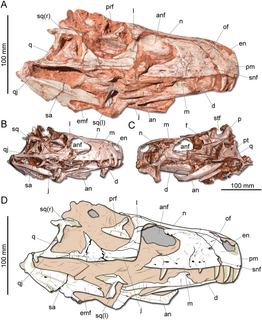 W
WGnathovorax is a genus of herrerasaurid saurischian dinosaur from the Santa Maria Formation in Rio Grande do Sul, Brazil. The type and only species is Gnathovorax cabreirai, described by Pacheco et al. in 2019.
 W
WGuaibasaurus is an extinct genus of basal dinosaur known from the Late Triassic Caturrita Formation of Rio Grande do Sul, southern Brazil. It was possibly a basal theropod or sauropodomorph. In 2016 Gregory S. Paul estimated it at 2 meters and 10 kg, whereas in 2020 Molina-Pérez and Larramendi listed it at 3 meters and 35 kg.
 W
WHyperodapedon is a genus of rhynchosaurs from the Late Triassic period. Fossils of the genus have been found in Africa, Asia, Europe and North and South America. Its first discovery and naming was found by Thomas Henry Huxley in 1859. Hyperodapedon was a herbivore that used its beaked premaxilla and hindlimbs to dig for plants in dry land.
 W
WIrajatherium is an extinct genus of cynodonts, known only of the type species Irajatherium hernandezi. It is named in honor of Irajá Damiani Pinto.
 W
WMacrocollum is a genus of unaysaurid sauropodomorph dinosaur that lived during the Late Triassic period in what is now Brazil. It is one of the oldest dinosaurs known.
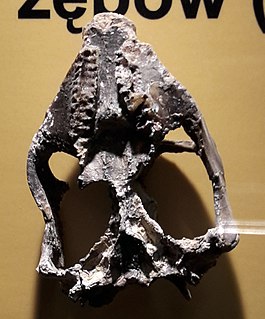 W
WMassetognathus is an extinct genus of plant-eating traversodontid cynodonts. They lived during the Triassic Period about 235 million years ago, and are known from the Chañares Formation in Argentina and the Santa Maria Formation in Brazil.
 W
WNhandumirim is a genus of saurischian dinosaur from the Carnian age of Late Triassic Brazil. The type and only species, Nhandumirim waldsangae, is known from a single immature specimen including vertebrae, a chevron, pelvic material, and a hindlimb found in the Santa Maria Formation in Rio Grande do Sul. Nhandumirim is differentiated from other Santa Maria dinosaurs such as Staurikosaurus and Saturnalia on the basis of its more gracile, long-legged proportions and several more specific skeletal features. It also possessed several unique features compared to other early dinosaurs, such as long keels on vertebrae at the base of the tail, a straight metatarsal IV, and a short brevis fossa of the ilium and dorsolateral trochanter of the femur. Several features of the tibia led the describers of the genus and species to consider Nhandumirim waldsangae the earliest theropod, but some analyses offer alternative positions within Saurischia.
 W
WPrestosuchus is an extinct genus of pseudosuchian in the group Loricata, which also includes Saurosuchus and Postosuchus. It has historically been referred to as a "rauisuchian", and was the defining member of the family Prestosuchidae, though the validity of both of these groups is questionable: Rauisuchia is now considered paraphyletic and Prestosuchidae is polyphyletic in its widest form.
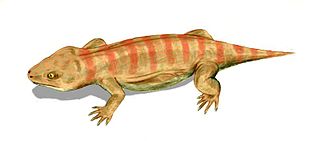 W
WProcolophon is a genus of lizard-like procolophonid reptiles that first appeared in the Late Permian (Lopingian) of South Africa, Brazil, and Antarctica. It persisted through the Permian–Triassic extinction event, but went extinct in the early Triassic. The type species is P. trigoniceps.
 W
WProterochampsa is a genus of proterochampsid archosauromorph from the Late Triassic (Carnian) Cancha de Bochas Member of the Ischigualasto Formation in the Ischigualasto-Villa Unión Basin in northwestern Argentina and the Alemoa Member of the Santa Maria Formation in the Paraná Basin in southeastern Brazil. It normally measured about 1.8 to 2 m, though P. barrionuevoi, known from a 44 centimetres (17 in) skull, could have grown up to 3.5 m (11 ft).
 W
WProtheriodon is an extinct genus of cynodonts which existed in the Santa Maria Formation of the Paraná Basin in southeastern Brazil during the middle Triassic period. It contains the species Protheriodon estudianti.
 W
WProzostrodon is an extinct genus of advanced cynodonts that was closely related to the ancestors of mammals. The remains were found in Brazil and are dated middle to late Triassic. It was originally described as a species of Thrinaxodon and was probably fairly similar to that genus in overall build. The sole find has a skull length of 6.7 cm, indicating the whole animal may have been the size of a cat, though there is some doubt as to whether the find represents an adult individual. The teeth were typical of advanced cynodonts, and the animal was probably a small carnivore hunting lizards and other small prey.
 W
WRiograndia is an extinct genus of tritheledontid cynodonts from the Late Triassic of South America. The type and only species is Riograndia guaibensis. Remains have been found in the Caturrita Formation of the geopark of Paleorrota. It was a small non-mammalian cynodont several advanced features also present in mammals. Several specimens of Riograndia guaibensis have been found in the towns of Candelária and Faxinal do Soturno in the Caturrita Formation. The genus defines the Riograndia Assemblage Zone.
 W
WSacisaurus is a silesaurid dinosauriform from the Late Triassic (Norian) Caturrita Formation of southern Brazil. The scientific name, Sacisaurus agudoensis, refers to the city where the species was found, Agudo in the Rio Grande do Sul state, whereas Sacisaurus refers to Saci, a famous one-legged creature from Brazilian mythology, because the fossil skeleton was found with a leg missing.
 W
WThe Sanga do Cabral Formation is a sedimentary rock formation found in Rio Grande do Sul, Brazil.
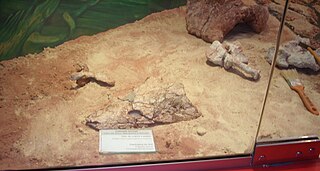 W
WSangaia is an extinct genus of rhytidosteid temnospondyl from the early Triassic period of Rio Grande do Sul, Brazil. It is known from the holotype UMVT 4302, the left half of a partial skull, a partial palate, from the paratype UMVT 4303, a partial right palatal fragment and from the referred specimens PV 0497 T and MCN PV 2606, skull fragments, recovered from the Sanga do Cabral Formation in the Rośario do Sul Group.
 W
WStahleckeria is an extinct genus of Middle Triassic (Ladinian) dicynodonts. It lived about 240 million years ago in what is now Brazil and Namibia. As a member of the group Kannemeyeriiformes, it was similar to the genus Kannemeyeria. The genus is known from the type species Stahleckeria potens, which was first collected from the Ladinian-age Santa Maria Formation in the Paleorrota fossil site of Brazil. Stahleckeria was named in honor of Rudolf Stahlecker, who discovered the first specimens during a 1935 expedition led by paleontologist Friedrich von Huene to the Chiniquá fossil site.
 W
WStaurikosaurus is a genus of herrerasaurid dinosaur from the Late Triassic of Brazil, found in the Santa Maria Formation.
 W
WTeyujagua is an extinct genus of small, probably semi-aquatic archosauromorph reptile that lived in Brazil during the Early Triassic period. The genus contains the type and only known species, T. paradoxa. It is known from a well-preserved skull, and probably resembled a crocodile in appearance. It was an intermediary between the primitive archosauromorphs and the more advanced Archosauriformes, revealing the mosaic evolution of how the key features of the archosauriform skull were acquired. Teyujagua also provides additional support for a two-phase model of archosauriform radiation, with an initial diversification in the Permian followed by a second adaptive radiation in the Early Triassic.
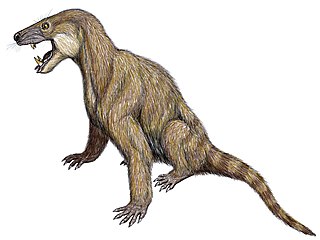 W
WTrucidocynodon is an extinct genus of ecteniniid cynodonts from Upper Triassic of Brazil. It contains a single species, Trucidocynodon riograndensis. Fossils of Trucidocynodon were discovered in Santa Maria Formation outcrops in Paleorrota geopark Agudo. T. riograndensis was similar to Ecteninion lunensis from the Upper Triassic Ischigualasto formation of Argentina, but differed in several respects, including its larger size. It is known from a nearly complete holotype skeleton as well as a referred skull. The holotype skeleton had an estimated length of 1.2 meters, while the referred skull was 17% larger than that of the holotype. Trucidocynodon is considered one of the largest known carnivorous cynodonts from the Triassic, as well as one of the largest probainognathians in the entire Mesozoic.
 W
WUnaysaurus is a genus of unaysaurid sauropodomorph herbivore dinosaur. Discovered in southern Brazil, in the geopark of Paleorrota, in 1998, and announced in a press conference on Thursday, December 3, 2004, it is one of the oldest dinosaurs known. It is closely related to plateosaurid dinosaurs found in Germany, which indicates that it was relatively easy for species to spread across the giant landmass of the time, the supercontinent of Pangaea.